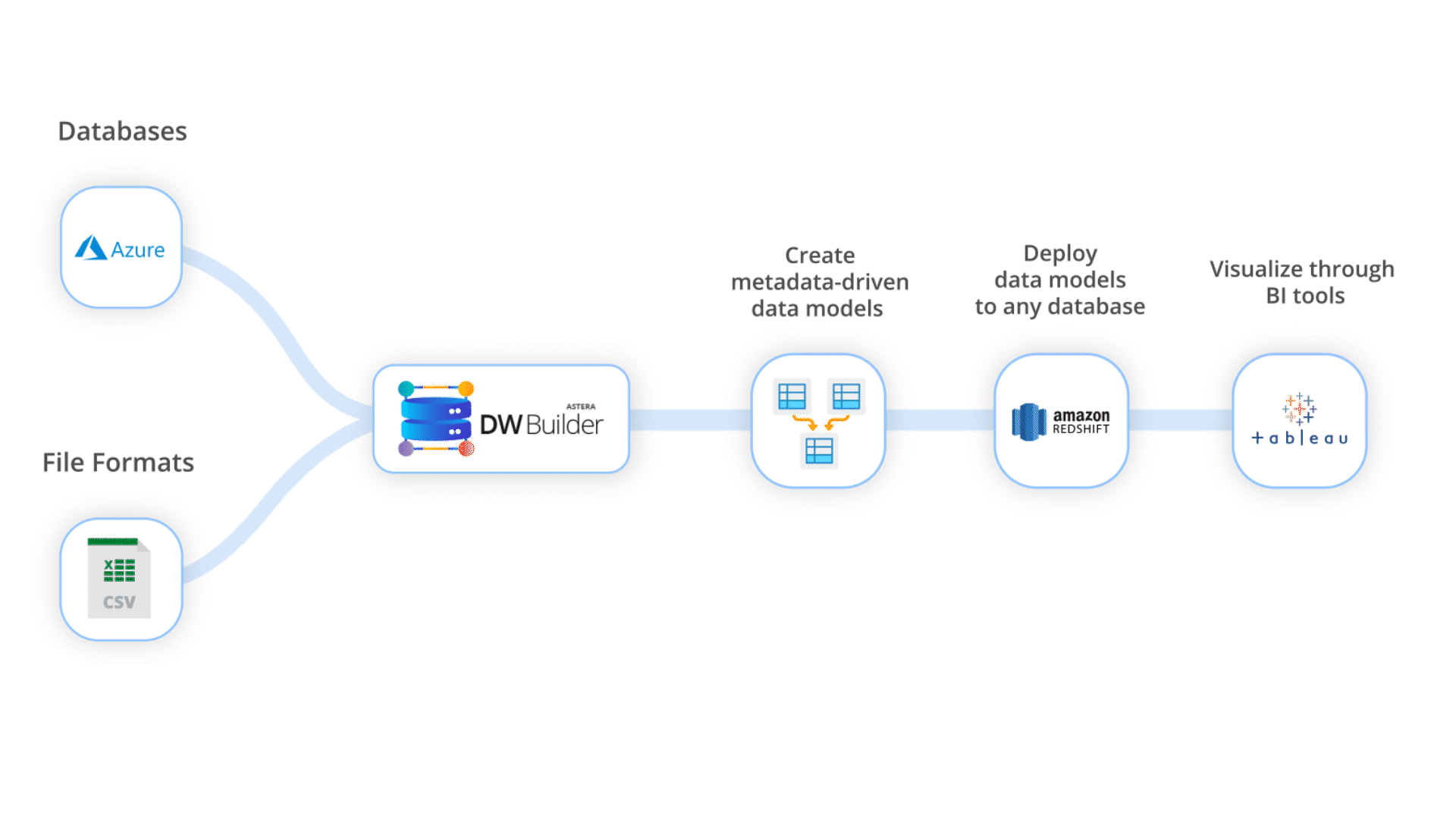Companies rely on multiple storage systems and technologies for their business intelligence (BI) initiatives. Two of the most popular technologies in use today are data warehouses and data marts. These centralized storage systems provide organizations with a single source of truth (SSOT) as it stores existing and historical data for analysis and data-driven decision-making.
But what is the difference between a data mart vs data warehouse?
This blog covers everything you need to understand the differences between a data mart and a data warehouse.
What is a Data Warehouse?
A data warehouse is a centralized data repository that stores large volumes of structured and often unstructured data from various sources within an organization. It is a versatile storage solution that empowers organizations across industries to break down data silos and gather actionable insights that drive strategic initiatives.
It is designed to enable businesses to make informed decisions based on historical and current data. The primary purpose of a centralized data warehouse is to offer a correlation between data from different data source systems, for instance, product information stored in one system and purchase order data stored in another system.
A well-designed data warehouse architecture facilitates efficient extraction, transformation, and loading (ETL) processes, ensuring seamless integration of disparate data sources into a centralized repository for data analysis. For instance, in e-commerce, a data warehouse can consolidate data from sales transactions, website interactions, and customer feedback, and ultimately provide a holistic view of customer behavior and market trends. This allows businesses to personalize marketing strategies and enhance overall customer experience.
Note that a data warehouse and a database are two different concepts. A data warehouse acts as a layer on top of a database and takes the information from different databases to create a layer for analytics.

What is a Data Mart?
A data mart is a specialized subset of a data warehouse that focuses on a specific business function, department, or user group within an organization. It is designed to provide different departments with access to relevant data so they can independently explore and extract insights from data specific to their unique requirements, ultimately fostering more informed and targeted decision-making. So, a data mart is usually focused on a business line or team and draws information from only a particular source.
For example, a retail company operating in multiple regions can implement data marts for each region within its broader data warehouse to analyze localized sales trends and customer preferences. This enables regional managers to make data-driven decisions tailored to their specific market dynamics. Likewise, a data mart could be established for risk management in a financial institution, consolidating data related to market trends and investment portfolios.
Based on their requirements, companies can use several data marts for different departments and opt for data mart consolidation by merging various marts to construct a single data warehouse later. Alternatively, they can design a data warehouse first and then create several data marts for every department, as required. These two different approaches are referred to as Kimball and Inmon data warehouse methodologies. Because of time and budget limitations, businesses usually opt for the Kimball approach.
Types of Data Marts
There are three types of data marts:
Dependent Data Marts
A dependent data mart is built using an existing data warehouse. It takes a top-down approach that starts with saving all business data in a single central location and then extracts a specific part of the data when required for analysis. It is essentially a subset of the larger data warehouse, focusing on a specific subject or business area.
Independent Data Marts
Unlike dependent data marts, independent data marts are standalone entities that are not directly connected to the data warehouse. Instead, an independent data mart architecture is built without a data warehouse. It is easy to develop for short-term goals. However, each independent data mart comes with its separate ETL tool and logic; therefore, they become hard to manage as businesses expand.
Hybrid Data Marts
As evident by the name, a hybrid approach combines elements of both dependent and independent data marts. This approach is particularly beneficial when certain departments require tailored data solutions while still benefiting from the coherence and governance of a centralized data environment.
It may have a core set of data directly sourced from the enterprise data warehouse to ensure consistency and alignment with the overall organizational data strategy. However, it also incorporates additional data from external or specific sources to address unique requirements within a particular business function.
Data Mart vs Data Warehouse
Data marts and data warehouses are sophisticated systems that serve as critical repositories to store vast amounts of data and extract meaningful insights for decision-making. However, there are important differences between a data warehouse and a data mart, especially when it comes to specific business requirements.
The table below summarizes data mart vs data warehouse:
| Data Warehouse |
Data Mart |
| A data warehouse is used to store data from numerous subject areas. |
A data mart carries data related to a department, such as HR, marketing, finance data mart, etc. |
| It acts as a central data repository for a company. |
It is a logical subsection of a data warehouse for particular departmental applications. |
| It is designed using star, snowflake, galaxy, or fact constellation schema. However, a star schema is used most widely. |
Data marts use a star schema for designing tables. |
| Tricky to design and use due to its large size (more than 100GB). |
Comparatively more manageable due to its small size (less than 100GB). |
| Designed to support the decision-making process in a company. |
Data marts are designed for particular user groups or corporate departments. |
| Data warehouses are used to store detailed information in denormalized or normalized form. |
Data marts hold highly denormalized data in a summarized form. |
| Has large dimensions and integrates data from many sources. |
Smaller dimensions to integrate data sets from a smaller number of sources. |
| Data warehouses are subject-oriented and time-variant with data existing for a longer duration. |
Data marts are used for particular areas related to a business, retains data for a shorter duration. |
When to use Data Mart vs Data Warehouse
Data marts are subsets of a data warehouse that serve specific business needs, while the data warehouse caters to the overall organizational data requirements.
The decision to use data marts or a data warehouse depends on the scale and specificity of your analytical needs. It’s all about finding the right balance to meet the diverse data needs of different parts of the business.
Use Data Warehouses for:
- Enterprise-wide Analysis: If your organization requires comprehensive and in-depth analysis across various departments and functions, a data warehouse is the way to go. It centralizes data from different sources and provides a unified view for comprehensive reporting and analysis.
- Data Integration: A data warehouse’s robust ETL processes become crucial in case you are dealing with diverse data sources that need to be integrated and cleansed. It ensures that data is consistent and reliable across the organization.
- Scalability: For large-scale data storage and processing, data warehouses offer scalability to handle massive amounts of data efficiently. They are designed to support the complex querying and reporting needs of an entire organization.
Use Data Marts for:
- Departmental Focus: If the analytics needs are specific to a particular department or team, implementing a data mart allows for a more focused and streamlined approach. Each department can have its own data mart tailored to its unique requirements.
- Quick Deployment: Data marts are quicker to deploy compared to large-scale data warehouses. If a specific business unit needs rapid access to analytics without waiting for the entire organization-wide infrastructure, a data mart provides a more agile solution.
- Cost Efficiency: Implementing data marts can be more cost-effective for smaller-scale projects. Instead of investing in a massive data warehouse infrastructure, you can build targeted data marts that fulfill specific needs, reducing both time and cost.
In practice, organizations frequently use a combination of both data warehouses and data marts. So, it’s not really a “when to use one over the other” situation, but more of a “how can they complement each other” scenario.
Data Mart vs Data Warehouse: Use Cases

Data warehouses are best suited for large-scale, enterprise-wide data integration and analysis, while data marts shine in scenarios where specific departments or teams require targeted and quick access to data for their specialized needs.
Use Cases for Data Marts
- Marketing Campaign Analysis
- Scenario: The marketing department wants to analyze the effectiveness of a recent campaign.
- Data Mart Role: You can assign a marketing data mart to store and analyze data specifically relevant to marketing activities. It could provide quick and targeted insights on metrics related to customer engagement and conversion rates.
- Sales Performance Tracking
- Scenario: The sales team needs real-time data on sales performance.
- Data Mart Role: You can create a sales data mart to offer quick and focused access to relevant sales data including individual salesperson metrics and regional sales trends.
- Financial Planning and Analysis
- Scenario: The finance department requires detailed financial data for budgeting and forecasting purposes.
- Data Mart Role: By implementing a financial data mart, you can store and provide the finance team with the specific information they need for planning and analysis.
Use Cases for Data Warehouses
- Enterprise-wide Reporting
- Scenario: A CEO wants a comprehensive report on the overall performance of the company.
- Data Warehouse Role: A data warehouse integrating data from sales, finance, marketing, and production provides a centralized repository necessary to view the end-to-end company performance.
- Historical Trend Analysis
- Scenario: An organization wants to analyze trends over the past 10 years to make long-term strategic decisions.
- Data Warehouse Role: Data warehouses store historical data efficiently, allowing for trend analysis and strategic planning based on a comprehensive historical perspective.
- Complex Queries for Business Intelligence
- Scenario: Business analysts need to run complex queries that involve aggregating and analyzing data from multiple sources.
- Data Warehouse Role: Data warehouses are optimized for complex queries, providing a platform for in-depth business intelligence and analytics.
Summing Up the Difference
Data warehouses are designed for comprehensive enterprise-wide data integration and analysis. They are the backbone for organizations seeking a holistic and unified view of their data, supporting strategic decision-making on an enterprise scale. Their purpose extends to facilitating comprehensive reporting, conducting historical trend analysis, and handling complex queries for in-depth business intelligence. Use a data warehouse if you need to harmonize data from various sources across the organization and build a single source of truth.
On the other hand, data marts are tailored for more specific, team-focused needs. Unlike implementing an enterprise data warehouse that may extend to several months or even years, data marts provide a more agile and targeted approach to data access for individual business units. Use data marts in scenarios where particular departments within your organization require specialized analytics without the need for the full-scale infrastructure of a data warehouse. Common use cases of a data mart include marketing campaign analysis, sales performance tracking, and financial planning and analysis.
Organizations often find a harmonious balance by employing both data warehouses and data marts. Together, they form a comprehensive data ecosystem, providing both the big picture and the detailed insights necessary for effective decision-making at various levels within the organization.
Astera Data Warehouse Builder
Whether your organization needs a data warehouse or a data mart, Astera Data Warehouse Builder (ADWB) automates the development process from end to end, saving you precious time and effort. It’s an all-in-one solution that enables you to design, develop, test, and deploy high-volume data warehouses in days, not months!
With Astera Data Warehouse Builder you can:
- Create data models from scratch
- Generate a data model for an existing database with a click
- Build your data warehouse using dimensional and data vault modeling
- Automate the data warehouse building process from end to end
And much more—all without writing a single line of code. Ready to build your enterprise data warehouse? Sign up for a demo. Alternatively, you can download a 14-day free trial and give it a test run.
Authors:
 Tehreem Naeem
Tehreem Naeem







